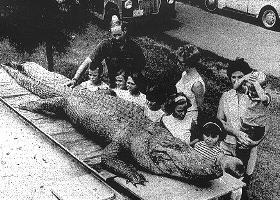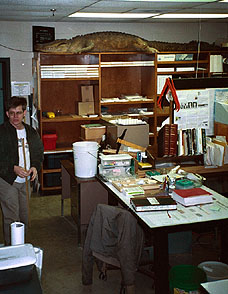 Arkie was measured again when he died eighteen years later. The length was an even thirteen feet. In eighteen years of captivity he had gained not one fraction of an inch.
Arkie was measured again when he died eighteen years later. The length was an even thirteen feet. In eighteen years of captivity he had gained not one fraction of an inch.Big Arkie, one of Arkansas' great cultural icons, has disappeared. He was captured in 1952 near Hope and at an even thirteen feet in length was billed as the largest captive alligator in the western hemisphere. After his death in 1970, Big Arkie was mounted and kept in the reptile house at the Little Rock Zoo. Conditions there were less than ideal for preserving the mount, so he was moved to the lobby of the new State Game and Fish Commission building. That is where I last saw Big Arkie back in 1990.
When I went down there to get his picture for this article Arkie was gone. Furthermore, nobody knows where he is. The people at Game and Fish don't know. The curator's office at the Arkansas Museum of Science and History doesn't know. The guy at the Arkansas Alligator Farm doesn't know, but he claimed to have once had a nineteen footer himself.
Arkie was captured in 1952 in a flooded pasture alongside Yellow Creek some 16 miles west of Hope by Ed Jackson, a caretaker at a hunting club. Jackson and several others captured Arkie, wrapping him in a cable at the end of a tractor.
Jackson offered Arkie to Bob Shivers for exhibition at the Hope livestock show. Shivers decided he didn't have the facilities to handle Arkie and ensure the safety of the spectators, so he contacted the Little Rock Zoo. Arkie spent the first day and night of his captivity in Hope's public kiddie pool, which was covered with chicken wire for the occasion.
The next day, when Arkie was taken to the Little Rock zoo, Marlin Perkins of the Lincoln Park Zoo was on hand to assist, as were several other Lincoln Park Zoo employees. You might remember Marlin Perkins from a wildlife show called "Mutual of Omaha's Wild Kingdom."
The hundreds of citizens who turned out to see the monstrous gator were disappointed because Arkie insisted on sulking at the bottom of the pool, surfacing only occasionally and only long enough to grab a quick breath. At the crowd's insistence, zoo director Raymond Gray pumped the water out of the pool so the crowd could see Arkie. Now exposed he lay still, as alligators like to do, so tormenters in the crowd started throwing rocks to try to get him to move. Gray had to enter the enclosure himself to get them to stop.
Gray measured Arkie with a garden hose. The length was an even thirteen feet.
 Arkie was measured again when he died eighteen years later. The length was an even thirteen feet. In eighteen years of captivity he had gained not one fraction of an inch.
Arkie was measured again when he died eighteen years later. The length was an even thirteen feet. In eighteen years of captivity he had gained not one fraction of an inch.
This photo from the Arkansas Gazette, August 29, 1970, shows a recently dead and freshly stuffed Big Arkie drying in the sun as local residents pay their respects.
I'll keep my eyes open and I'll keep asking around to see if I can locate Arky's remains. Prospects don't look good, though. Most of the people I talk to, especially those born since 1970, don't know much about Big Arkie and don't seem to think finding him is all that important.
Since 1970, there have been a couple of alligators to pass the thirteen foot mark. A good place to get a quick overview of other giant gators in America is with The Roadside Project.
RTJ--12/9/97
 Thanks to a tip from Billy Whitener Big Arkie has been found, and there he is in the Herpetology Collection of the Museum of Zoology at Arkansas State University. It's not open to the public because it's a reference museum with shelves and shelves of gallon pickle jars stuffed with lizards, frogs, snakes, turtles, newts and salamanders. If you want to visit Big Arkie in person, you'll have to get one of the staff to let you in.
Thanks to a tip from Billy Whitener Big Arkie has been found, and there he is in the Herpetology Collection of the Museum of Zoology at Arkansas State University. It's not open to the public because it's a reference museum with shelves and shelves of gallon pickle jars stuffed with lizards, frogs, snakes, turtles, newts and salamanders. If you want to visit Big Arkie in person, you'll have to get one of the staff to let you in.
This is my guide, Malcolm McCallum, a PhD candidate studying under Dr. Stanley Trauth, the head herpetologist and curator of the collection. Dr. Trauth has a magnum opus of a reference book on Arkansas species coming out soon. I got a look at an inkjet copy, and it's impressive stuff. Look for it in the autumn of '03 under the title "The Amphibians and Reptiles of Arkansas," by Stan Trauth, Henry Robison, and Mike Plummer.
Back to the gator. Big Arkie was adopted thirteen or fourteen years ago by Dr. Trauth from the Arkansas Game and Fish Commission. He was stored for many years in the rafters of Dr. Trauth's office held overhead by the supporting grid of the suspended ceiling. About four or five years ago (about the time I was writing the original story) Arkie was moved to his present location in the museum. I had recieved a tip that Arkie was at the ASU museum, but I went to the main campus museum and saw a mere nine footer on display. I just assumed my tipster was in error, but it's a wiser man that I who finds what he's looking for and keeps on looking.
Parked by Arkie's nose is the plaque that attended the mount since 1970. Here's the text:
I have to wonder about the line "Considered largest alligator in captivity in the western hemisphere." The peculiar use of passive voiced fudge words like "considered." Also limiting the claim to the western hemisphere for a species that occurs only in the western hemisphere seems unnecessary. Why not say "world's largest damn gator?" It seems to imply that somebody did some research and found a bigger one in a zoo in the Old World somewhere, but then if somebody did research the question well enough to find a bigger one half a world away, why use the fudge word "considered" when claiming the giant gator title of the New World?
Thirteen foot alligators are extremely rare, and Arkie was at the Little Rock Zoo for eighteen years. Surely at least part of that time he was the world's largest captive alligator.
The mount is in much better shape that I had been led to believe. There was some damage to the left rear foot, as if the toes had been gnawed off by a dog; but a good detailed rub down with some leather care product might do him as much good as anything.
Big Arkie may be viewed by appointment in the Life Sciences West Building of the Arkansas State University Jonesboro Campus. Phone 870-972-3082.
RTJ--02/05/2003